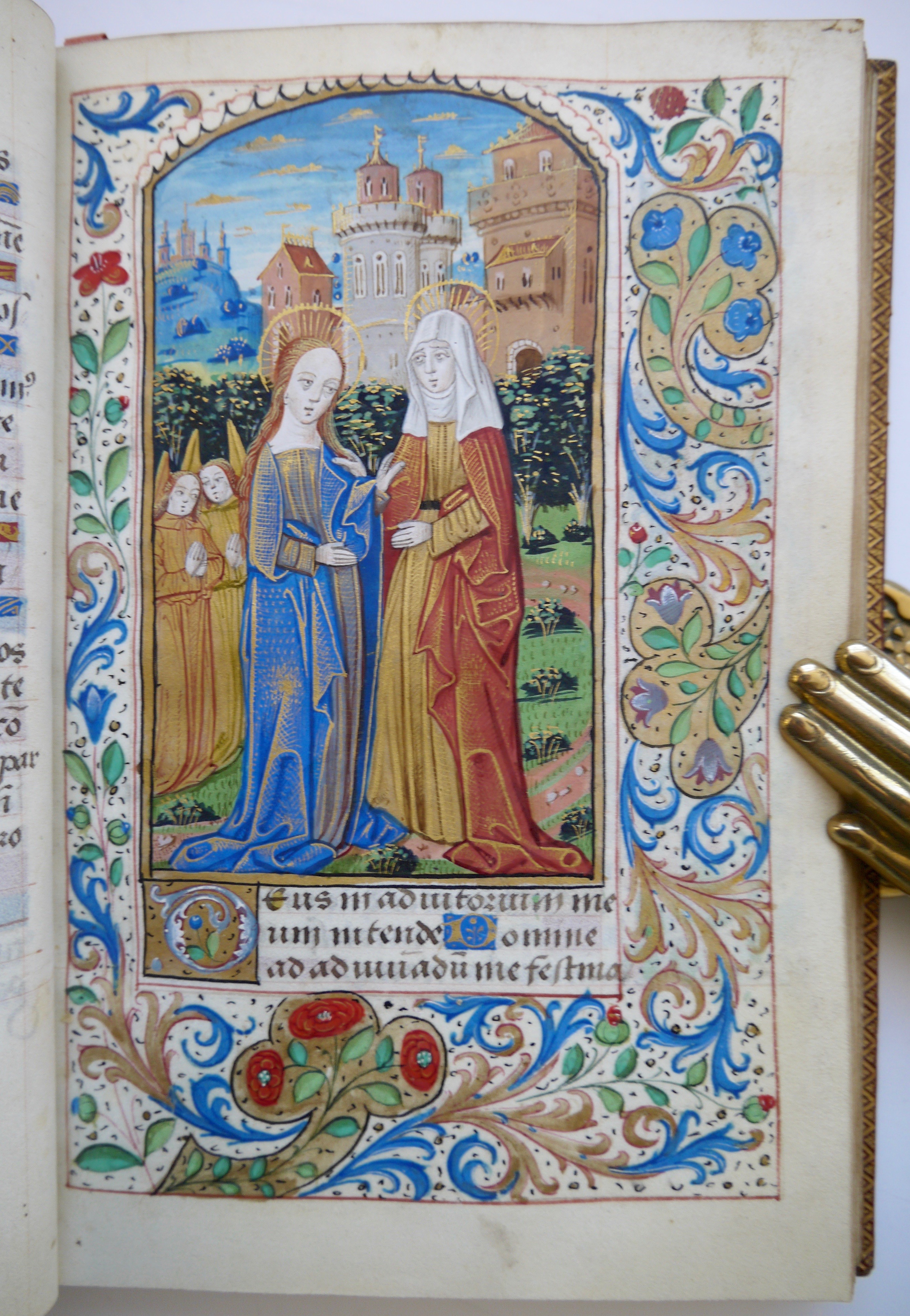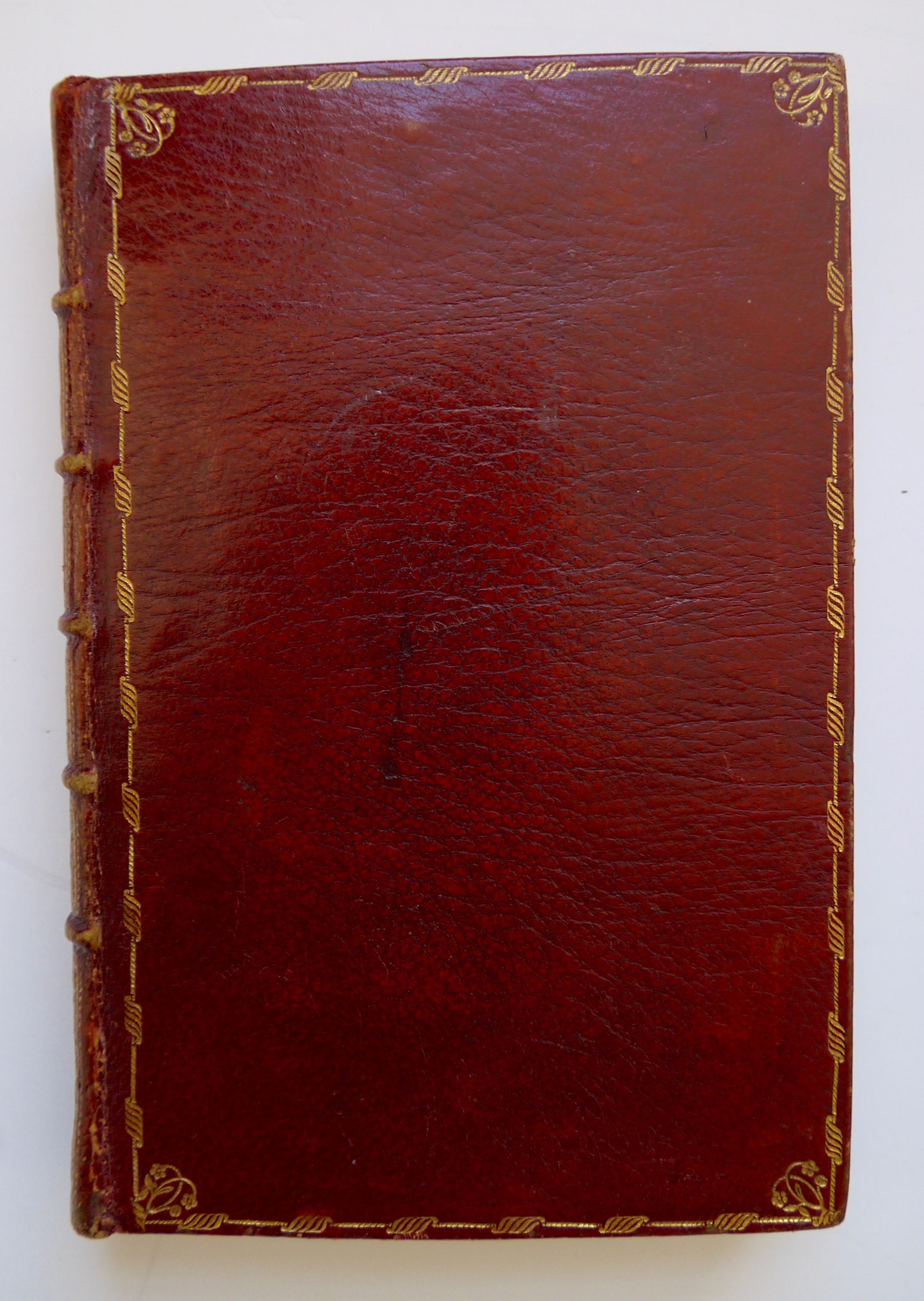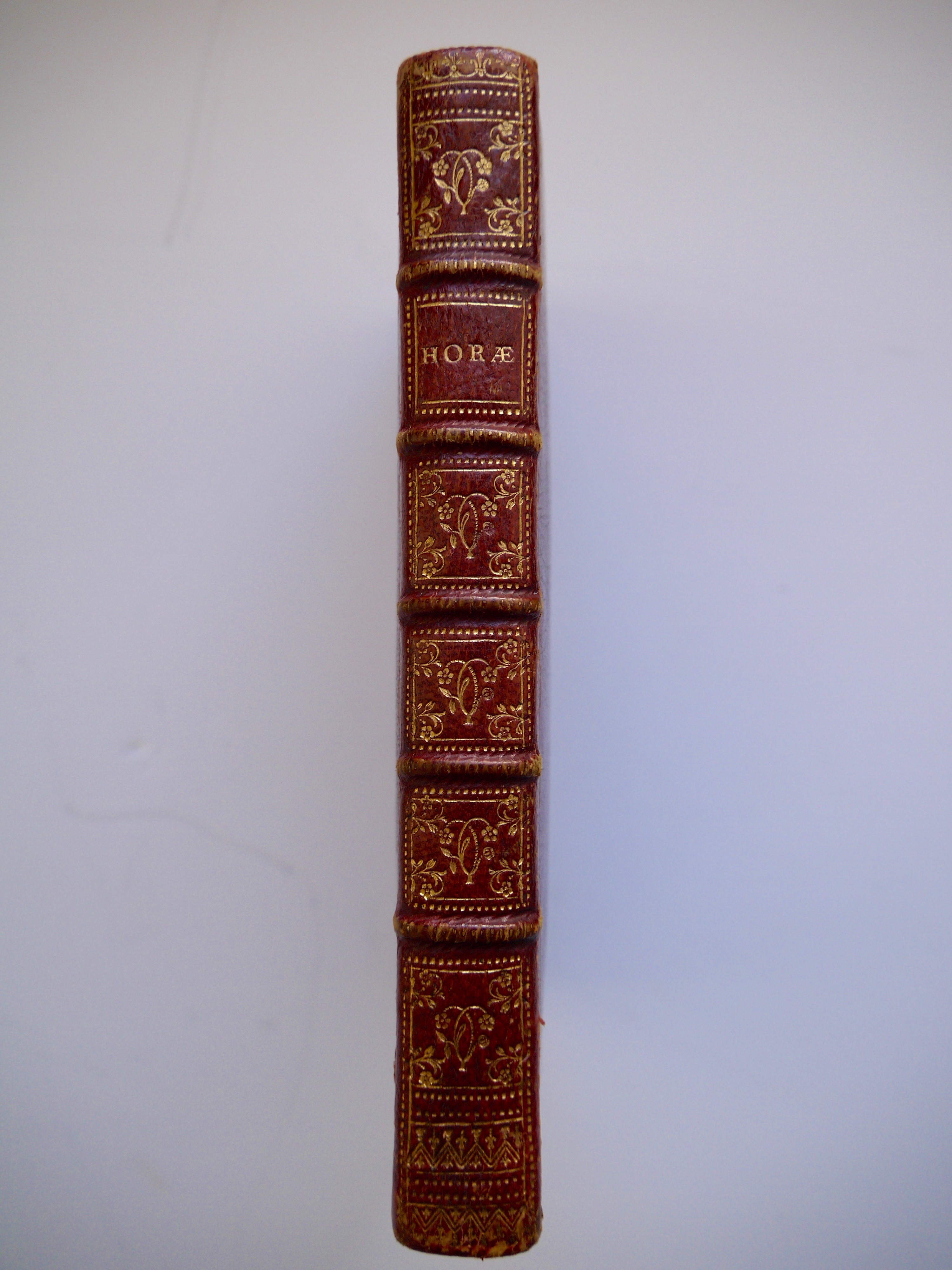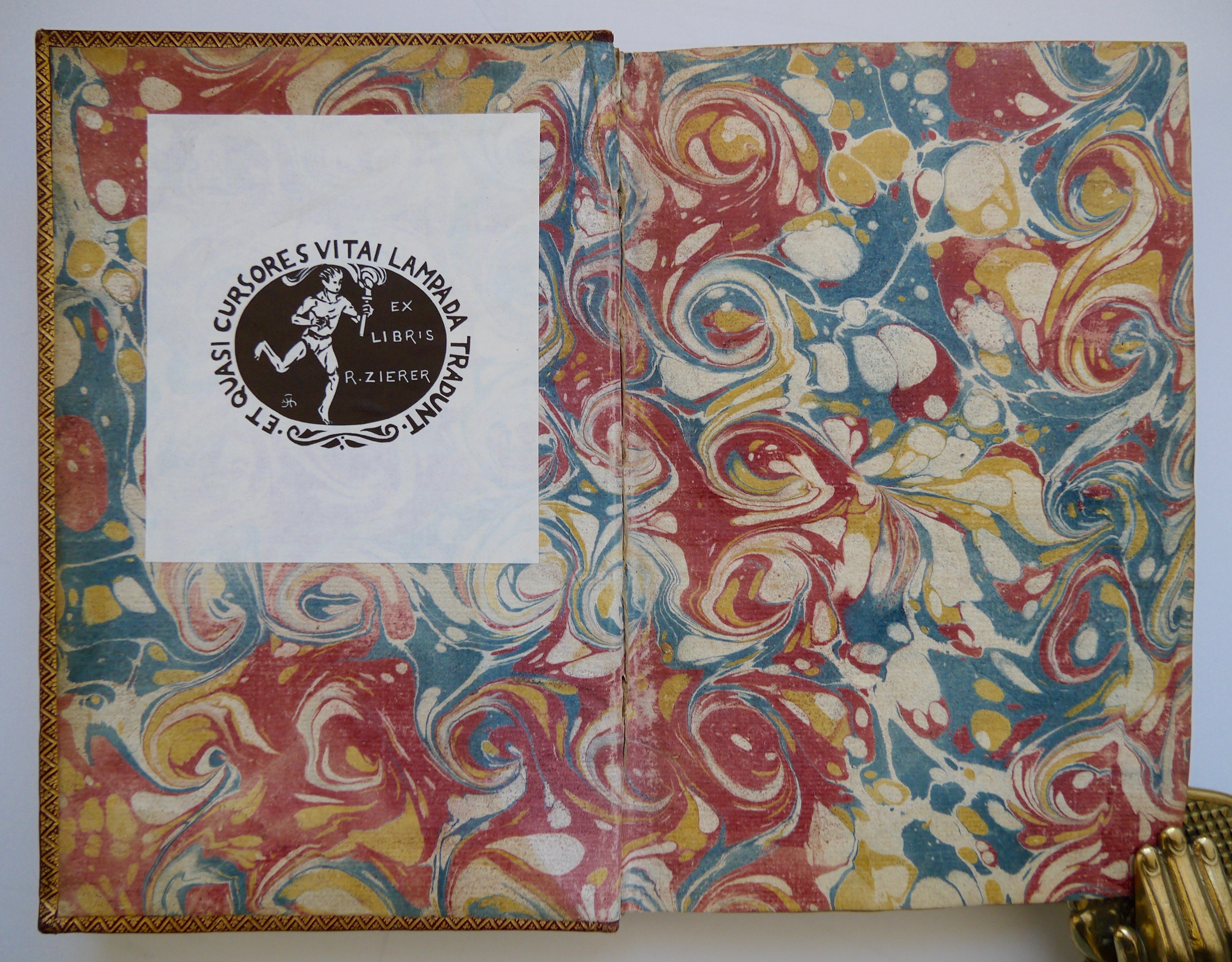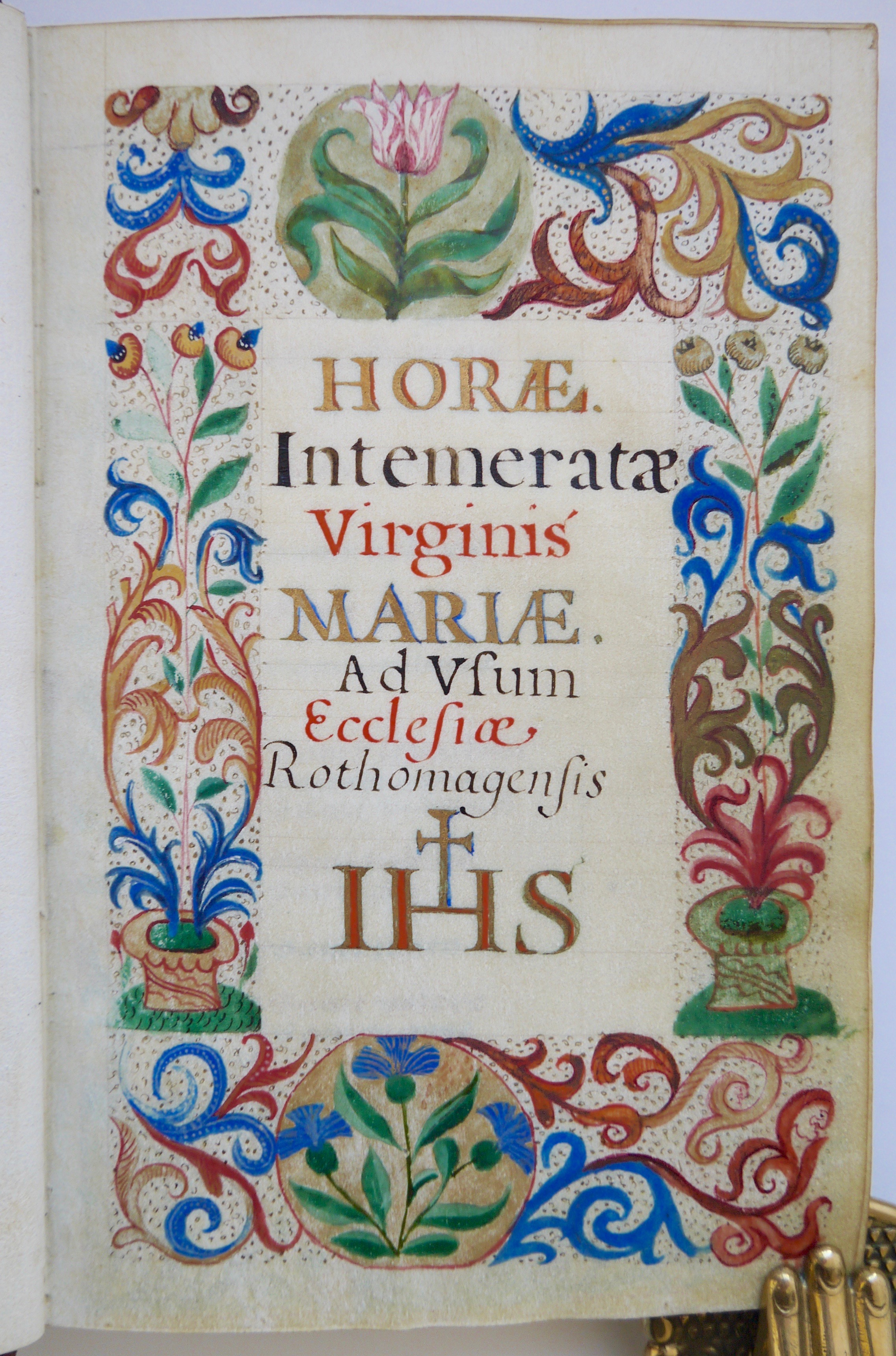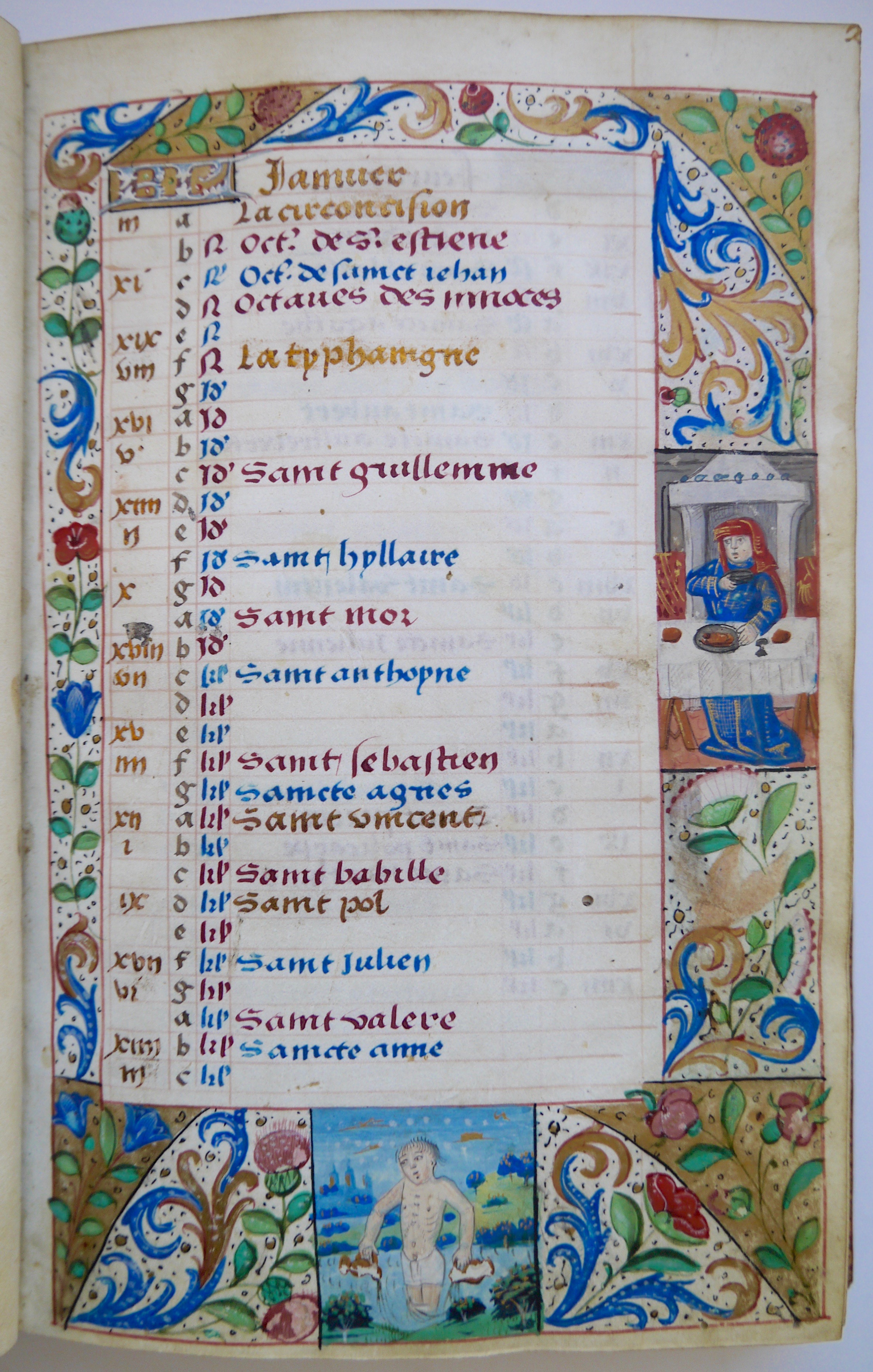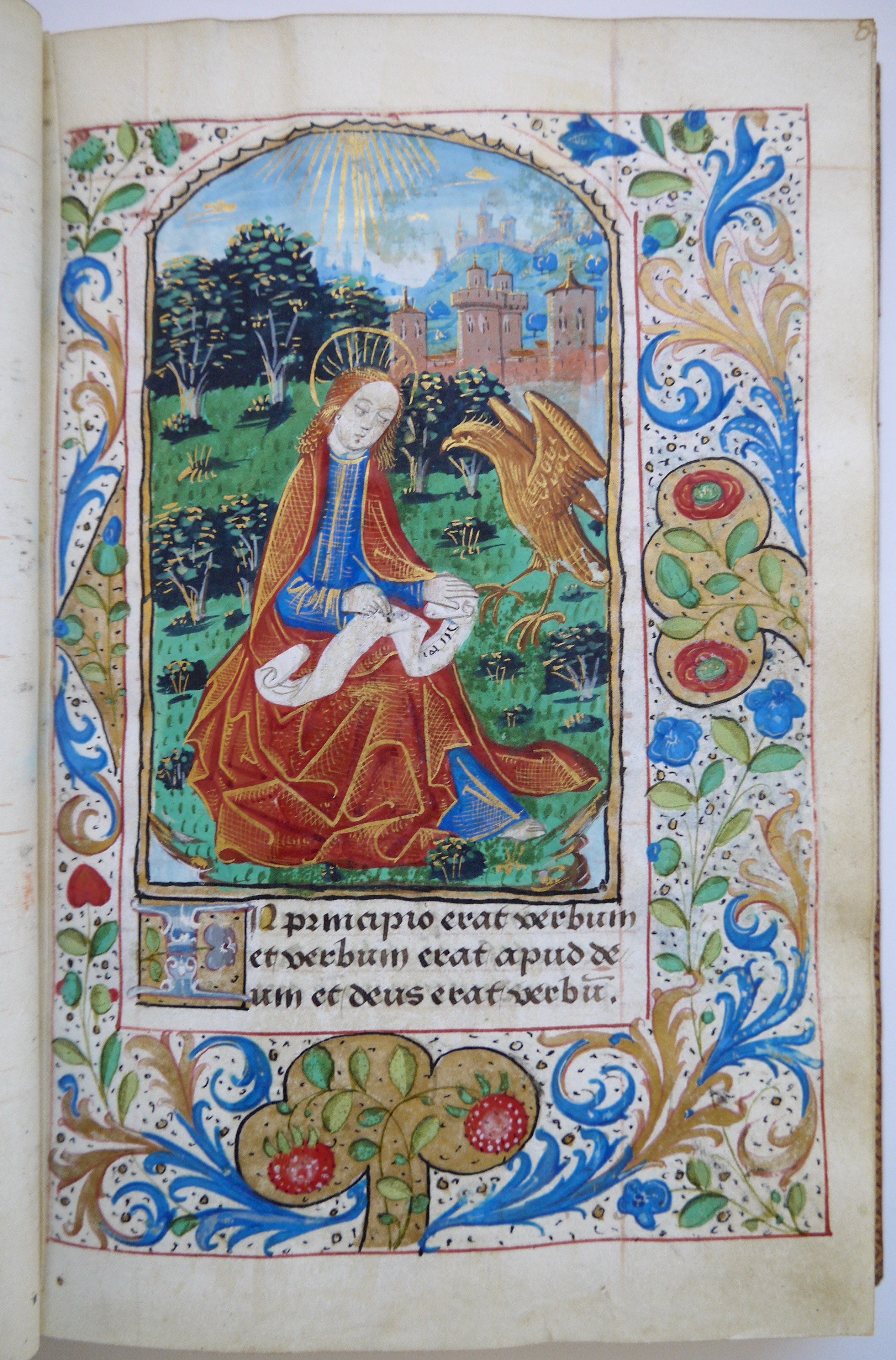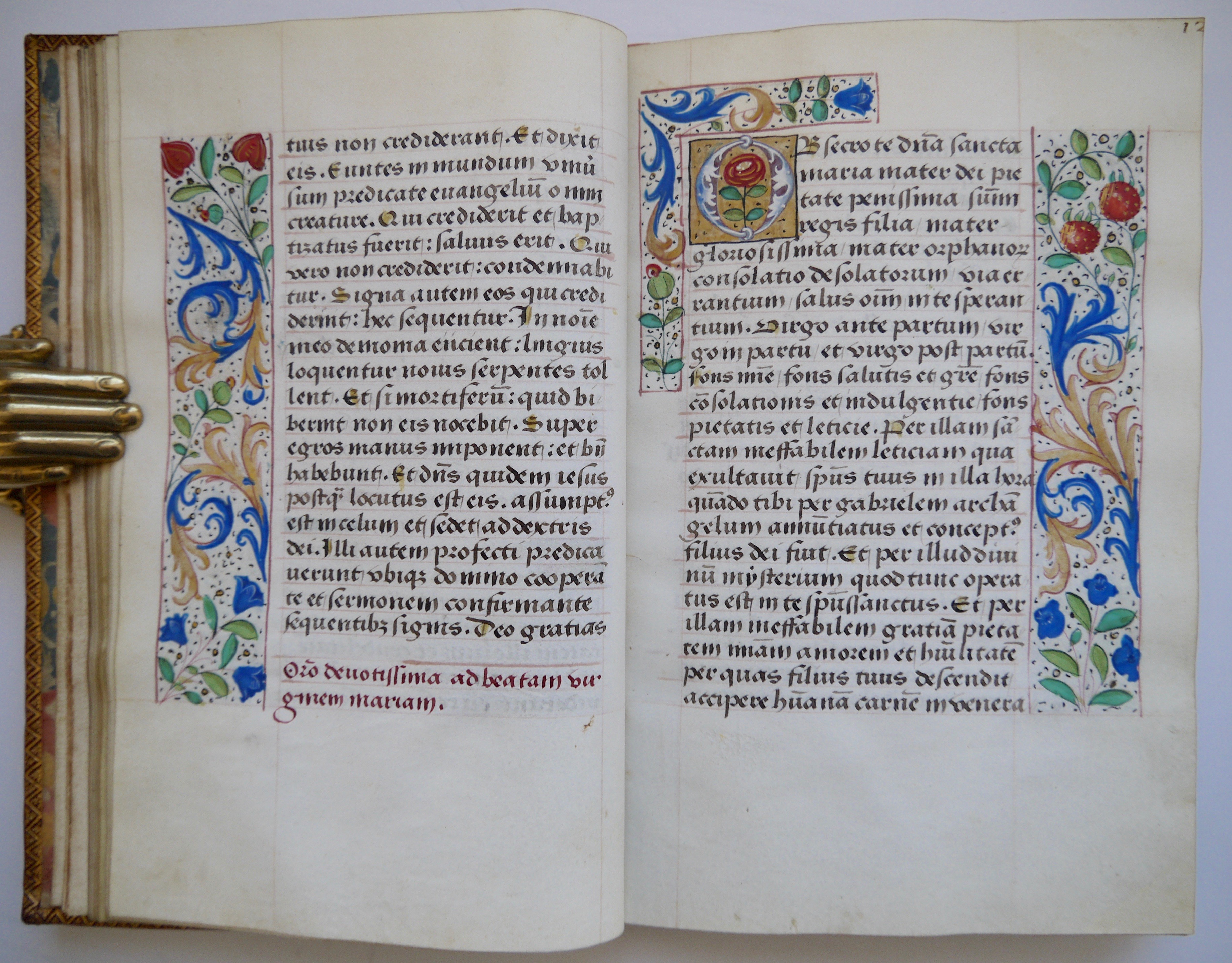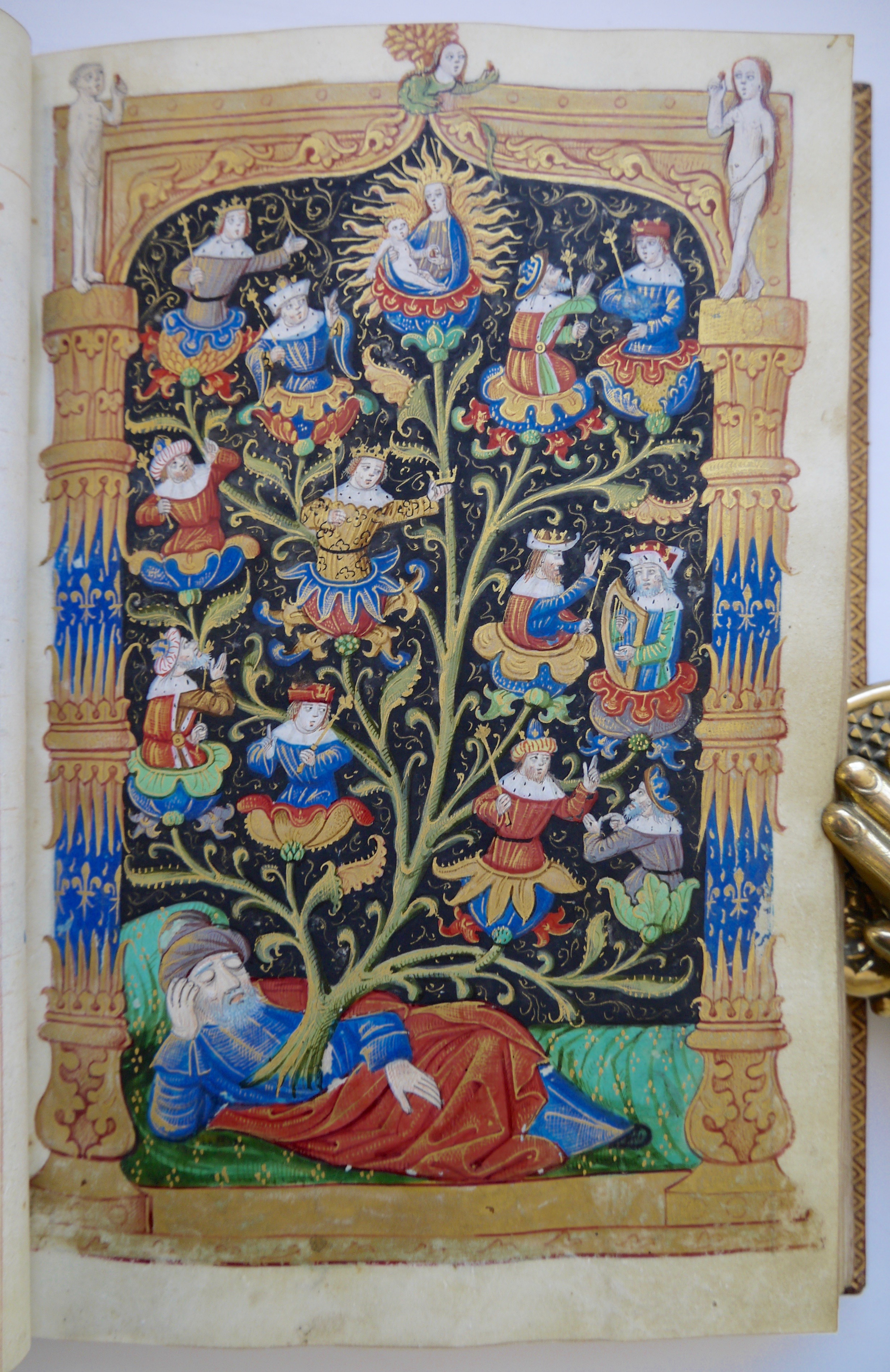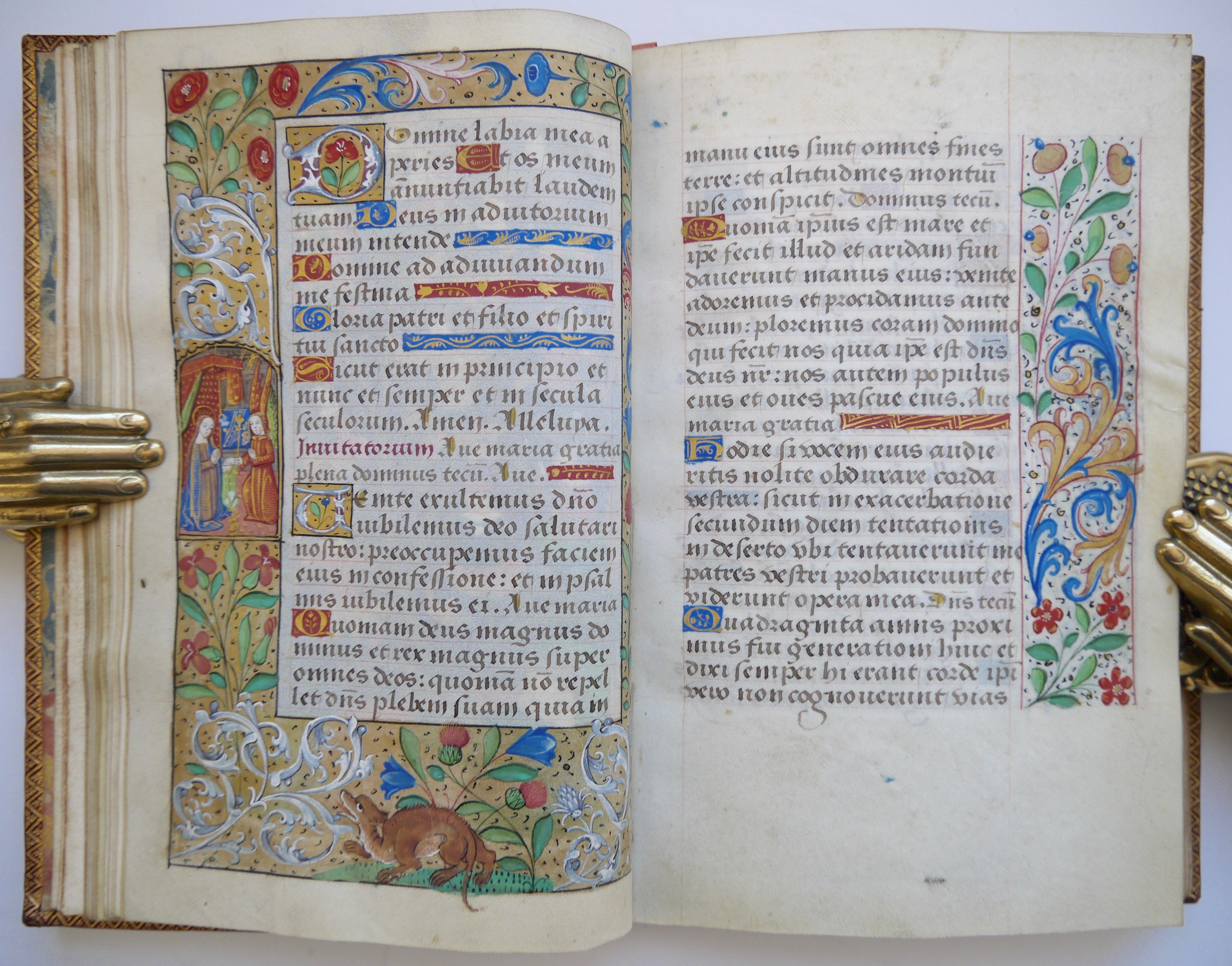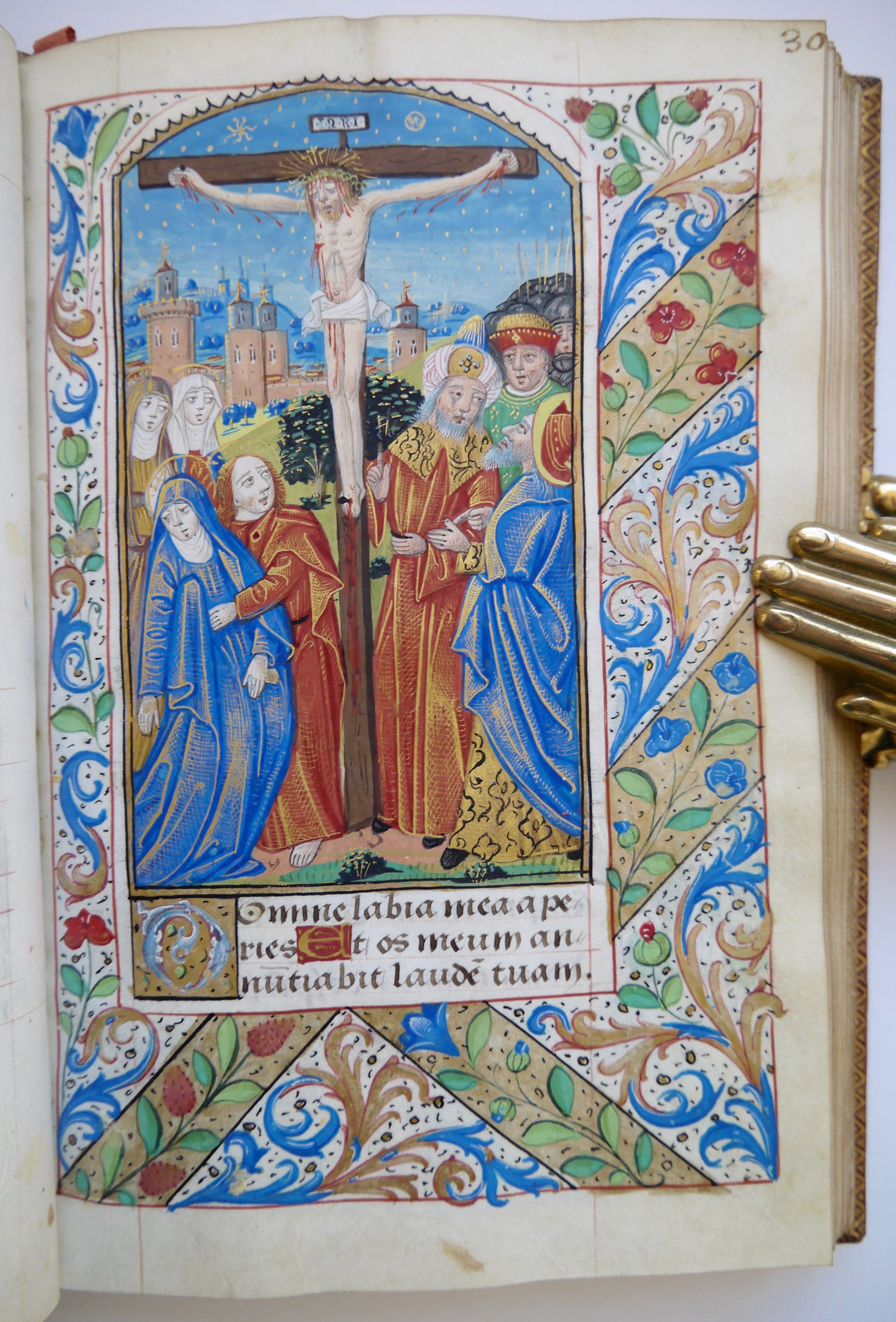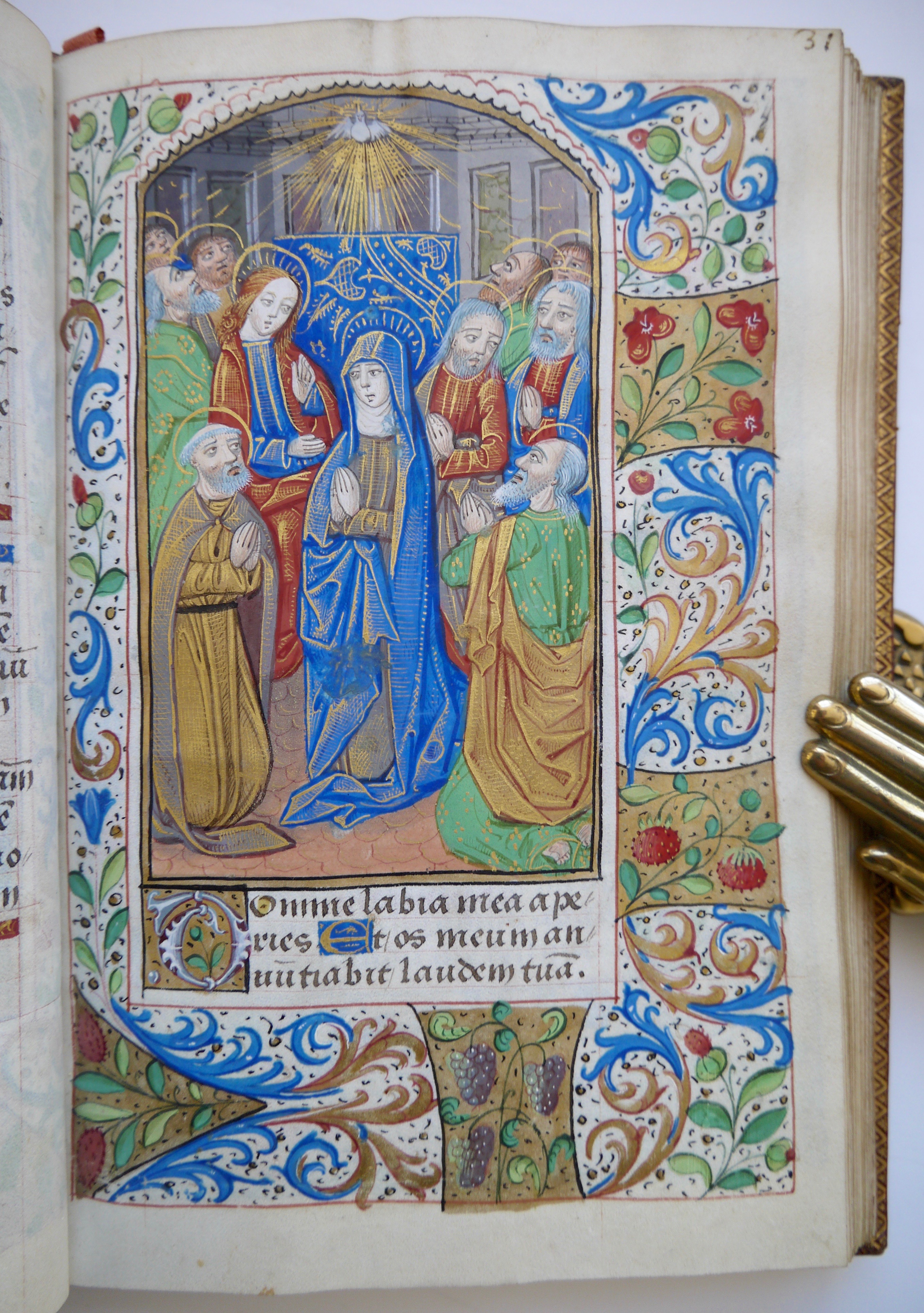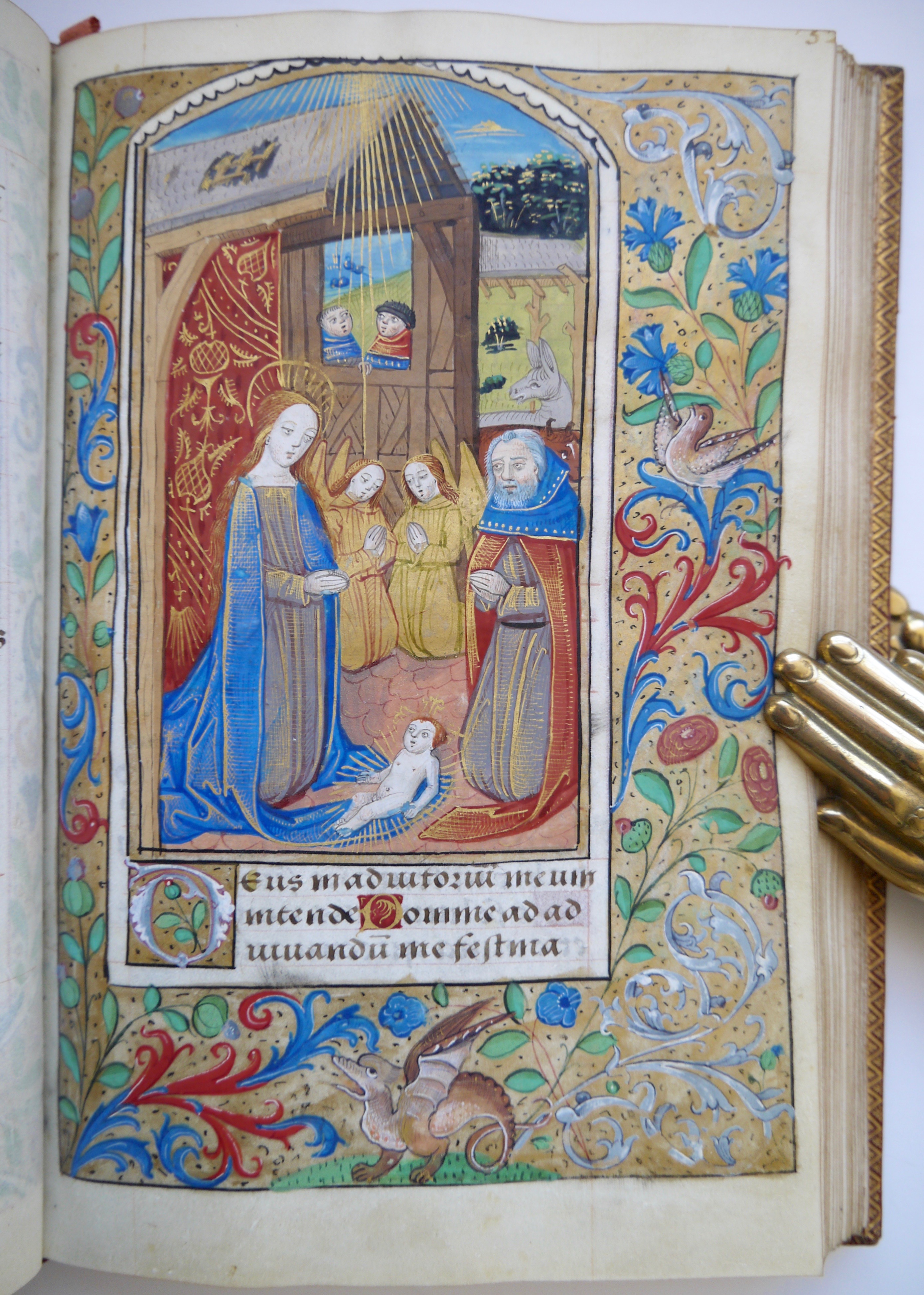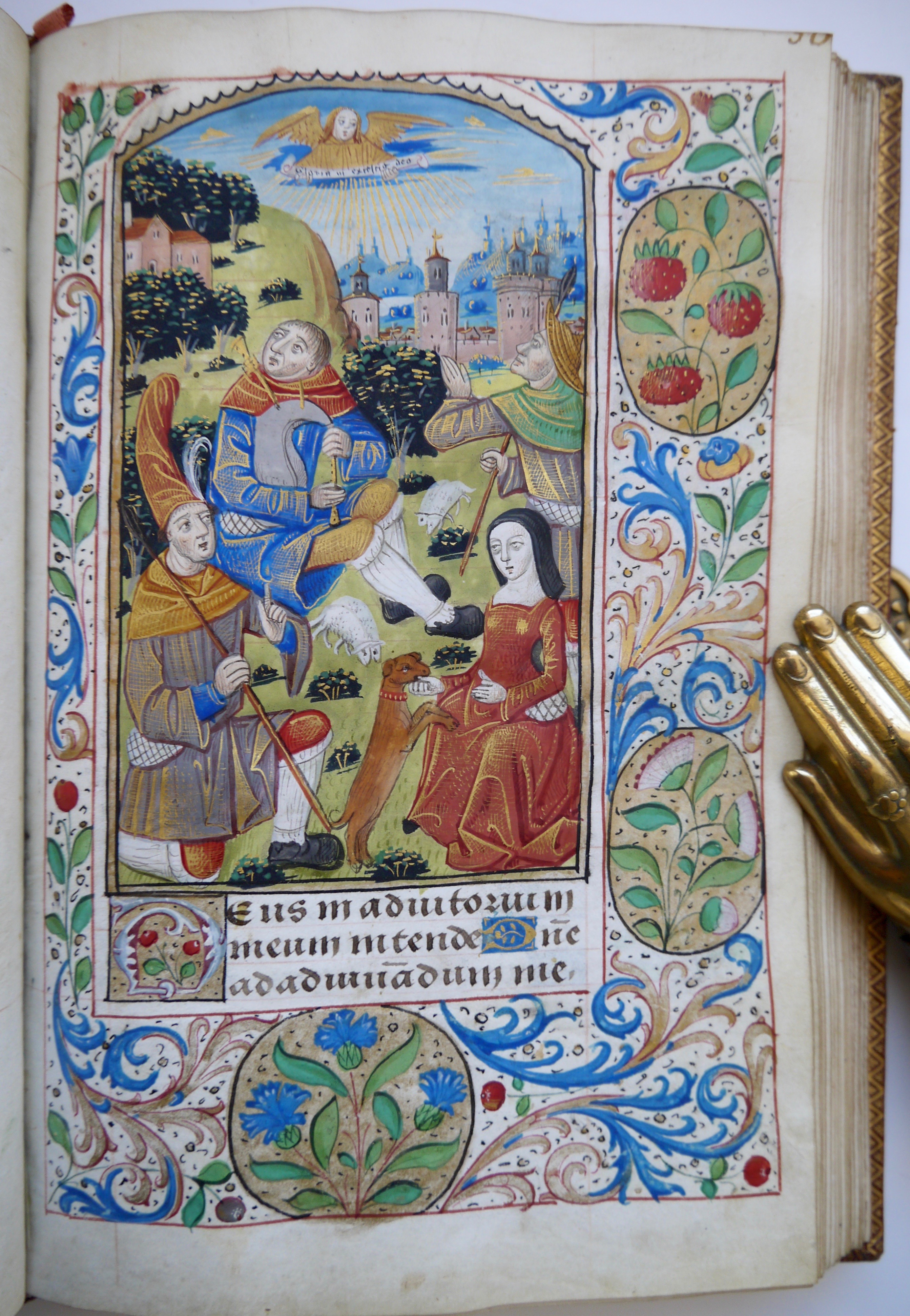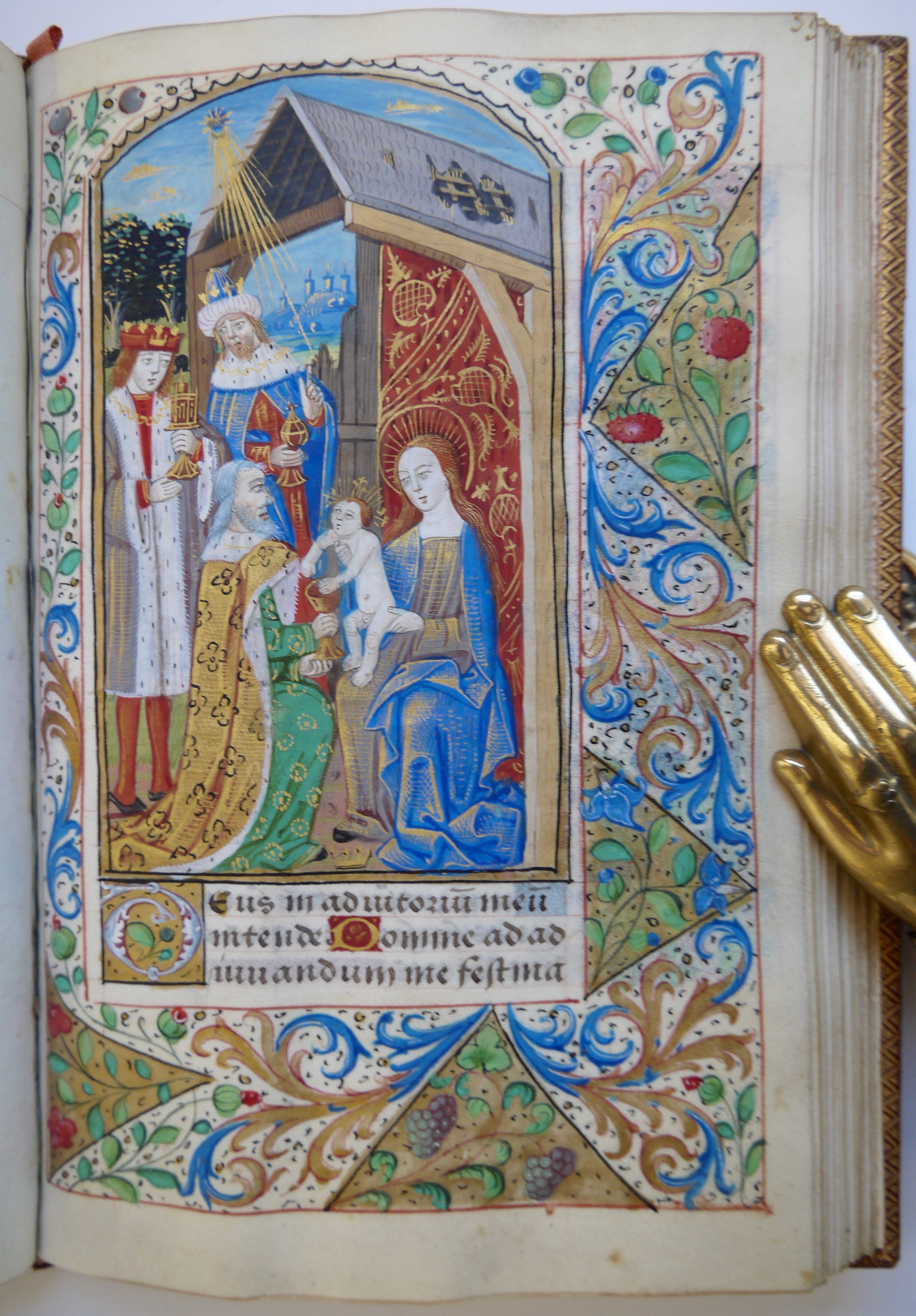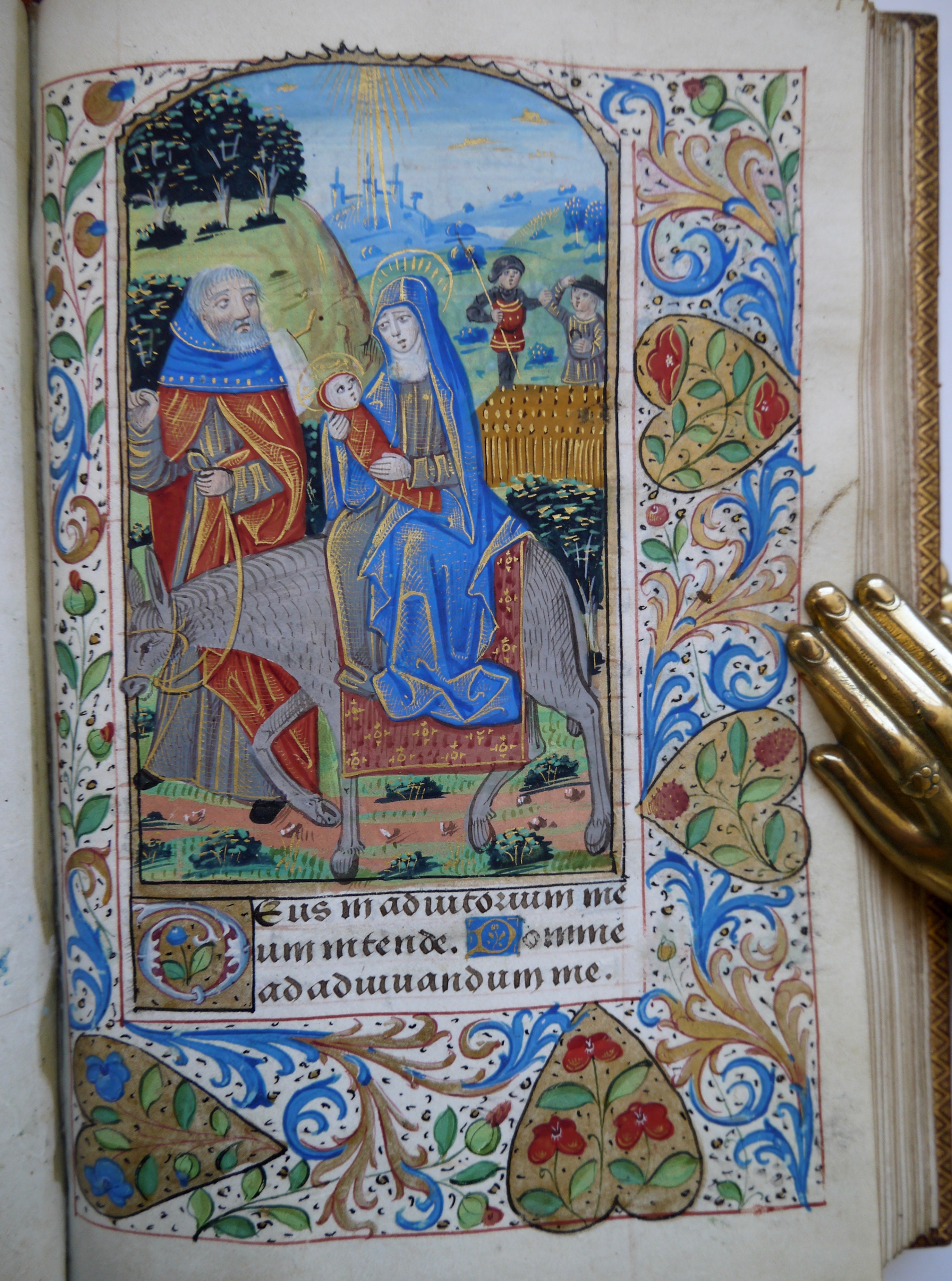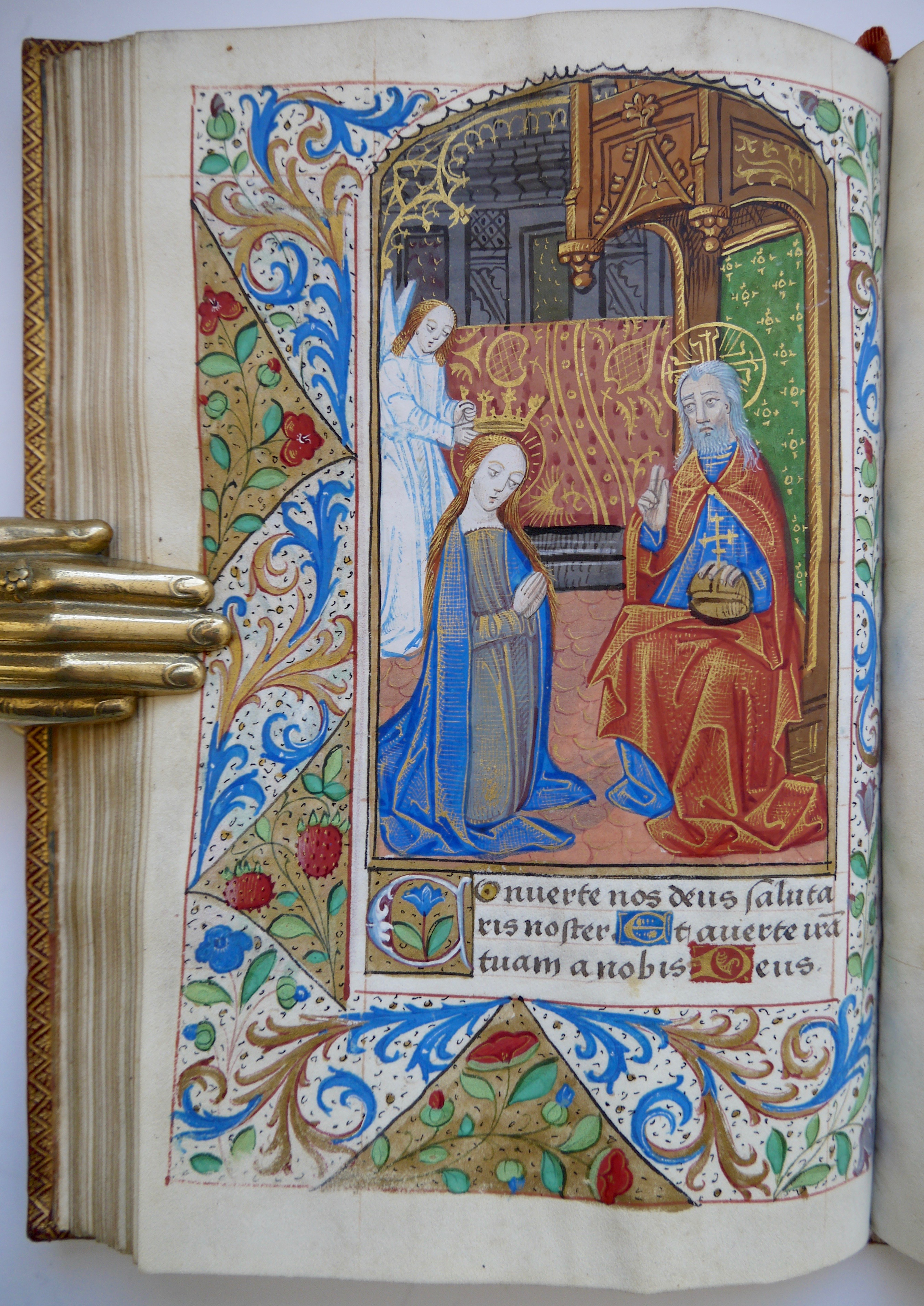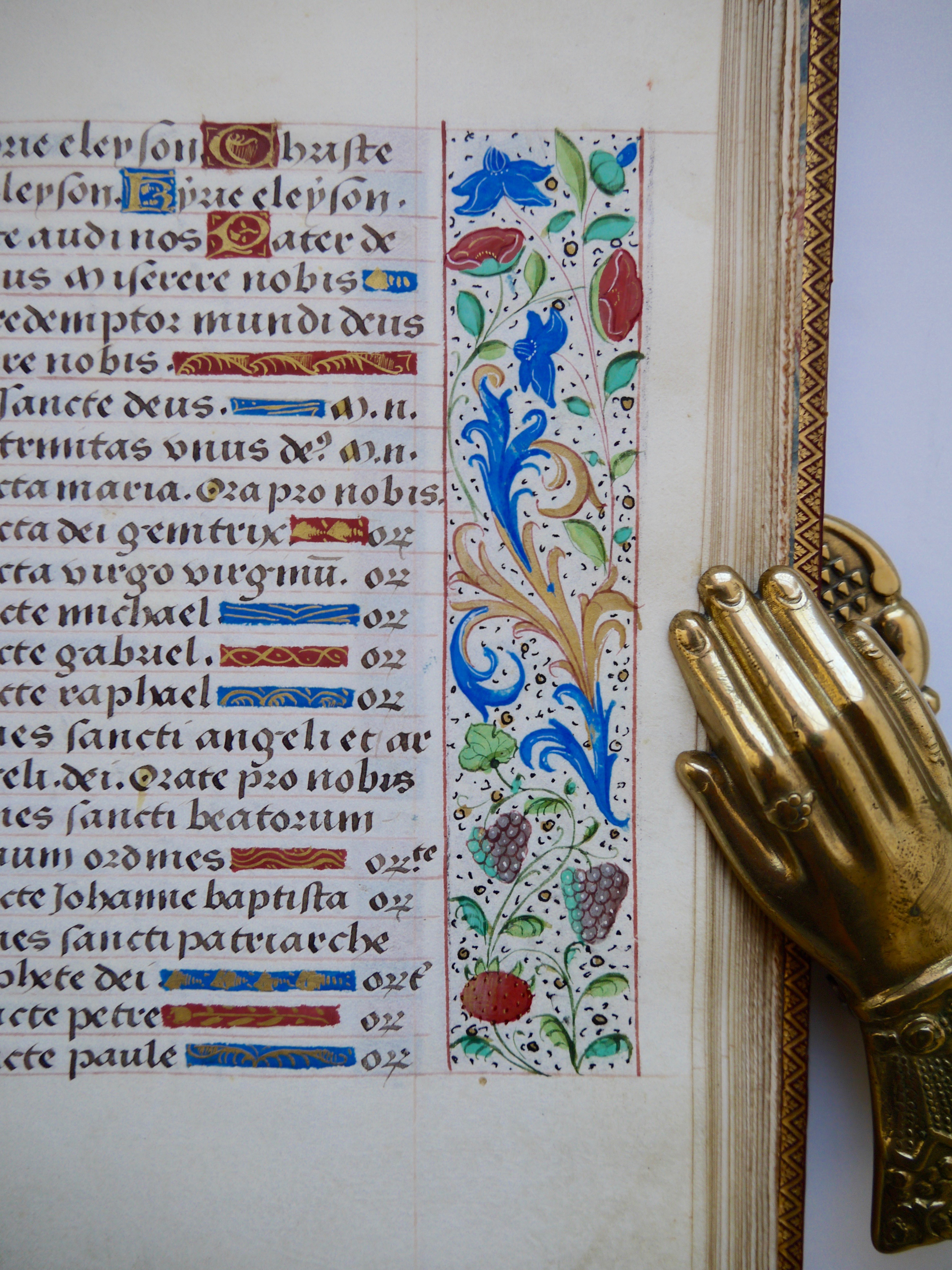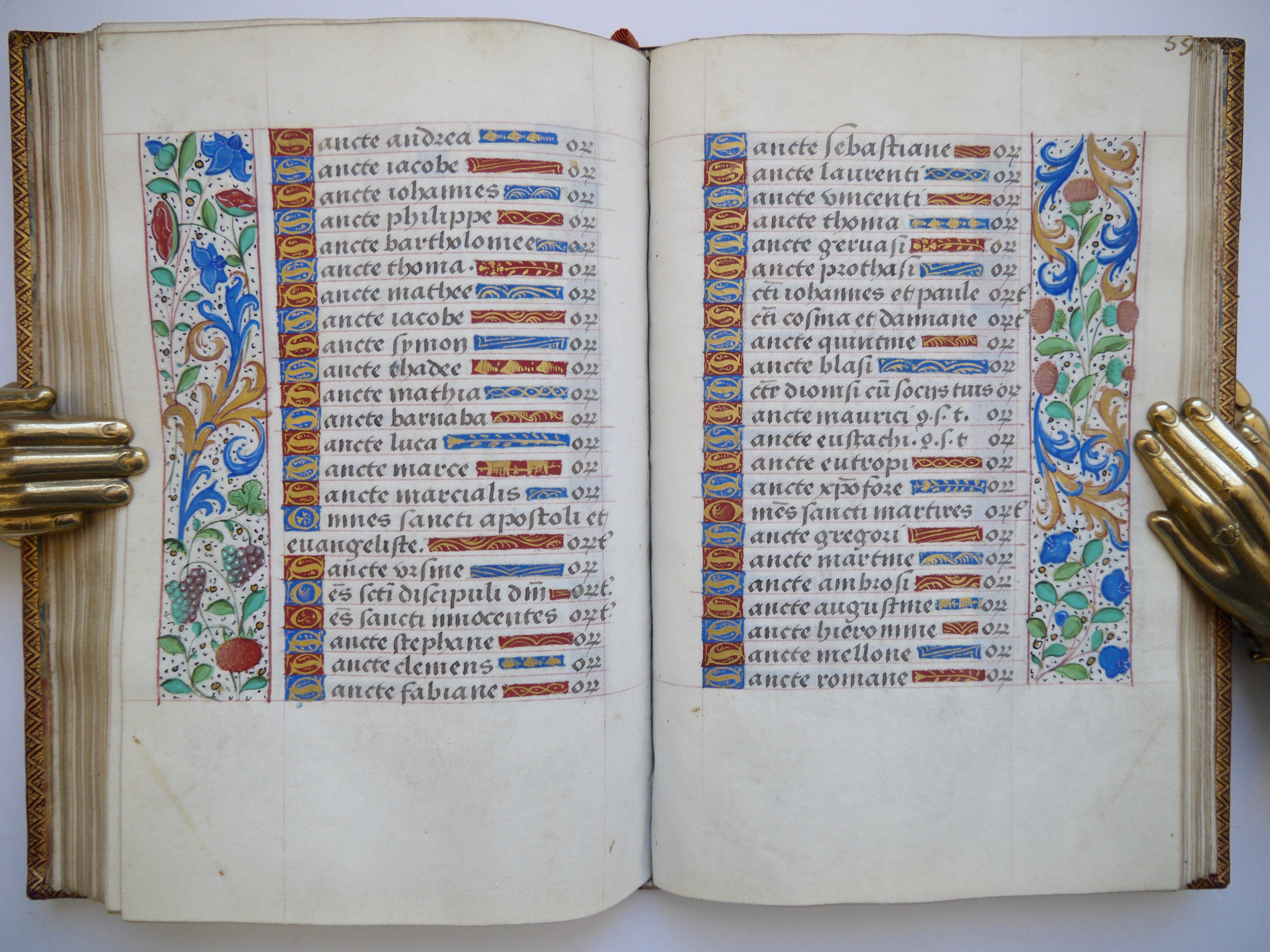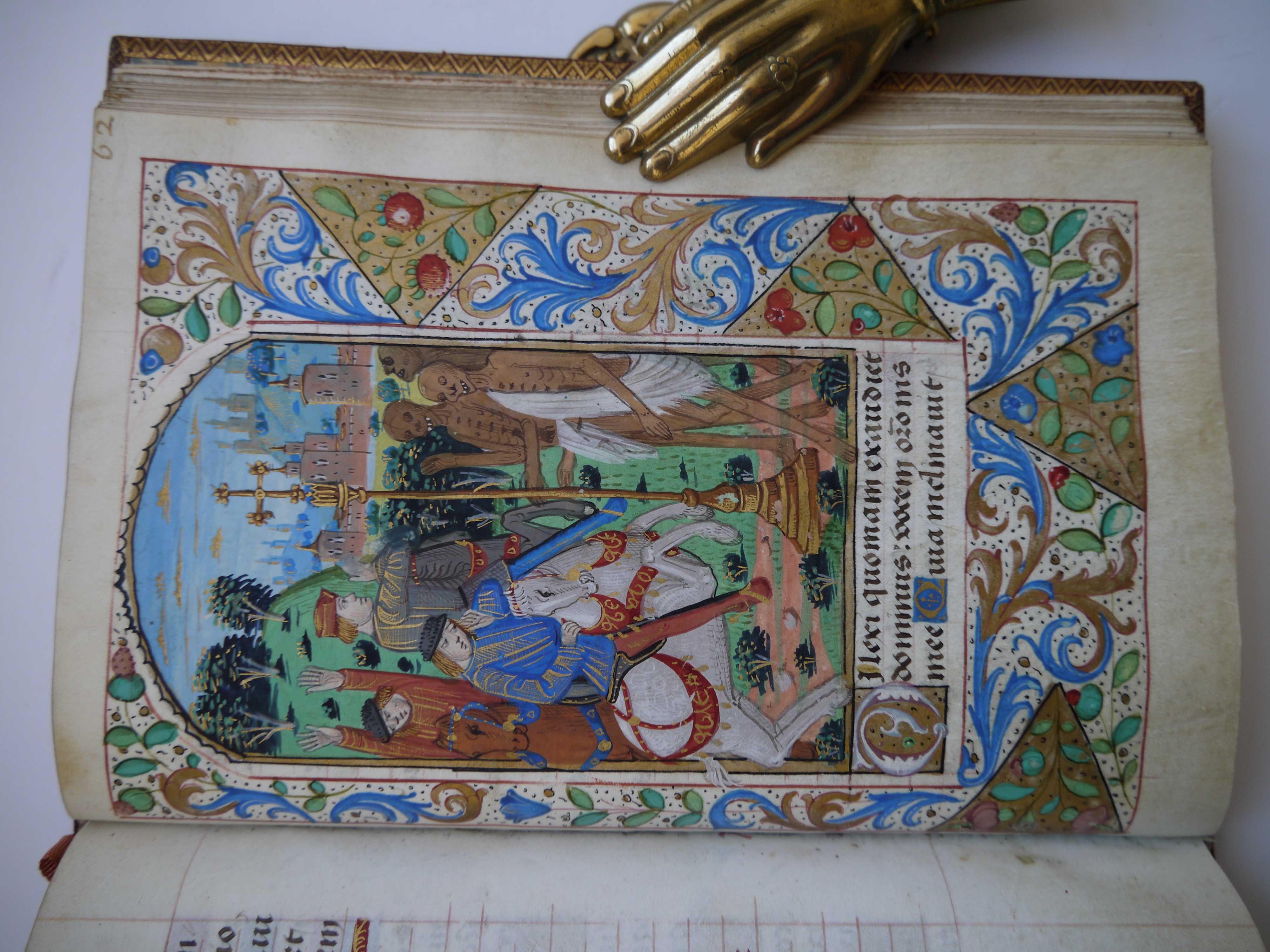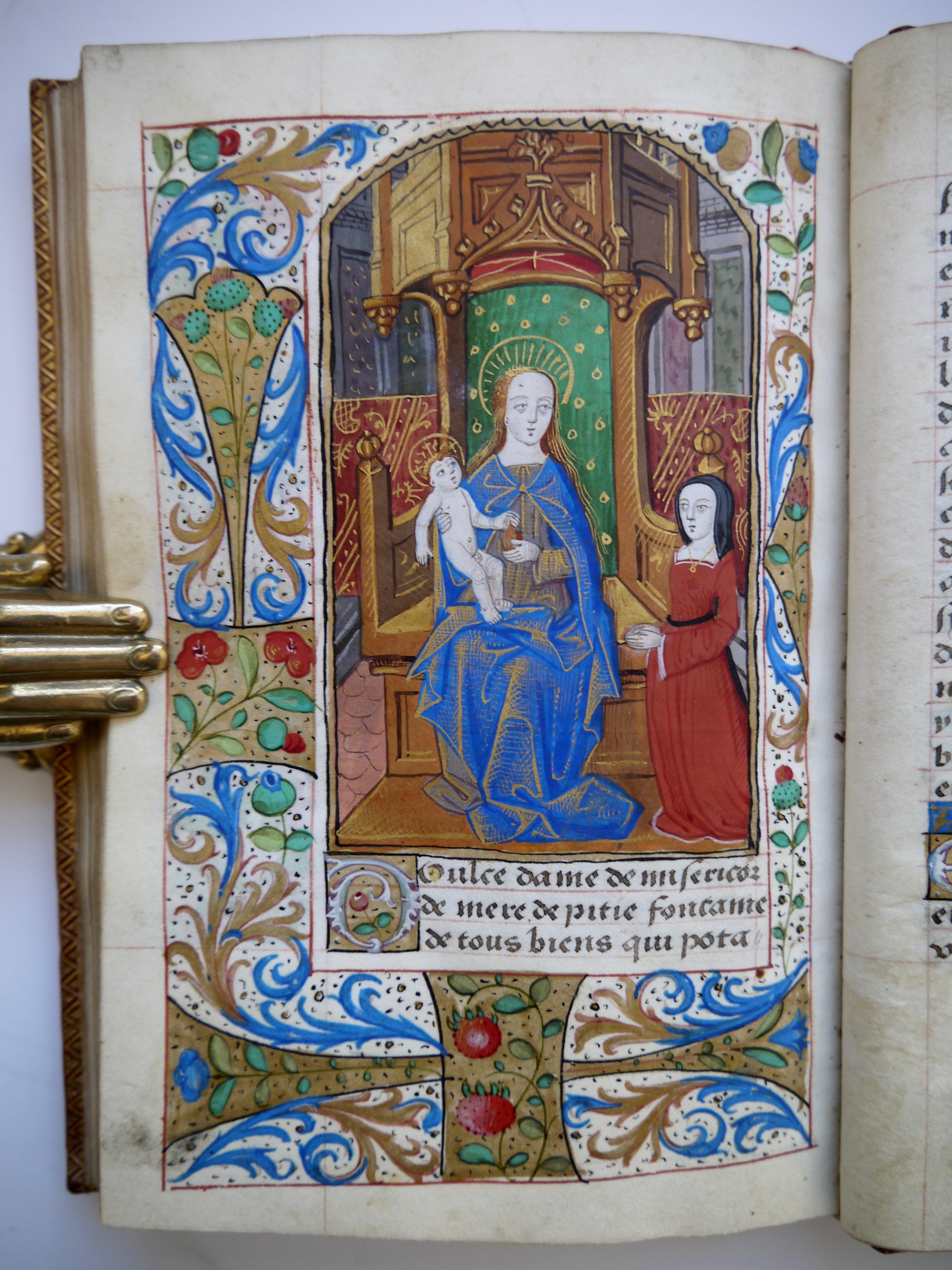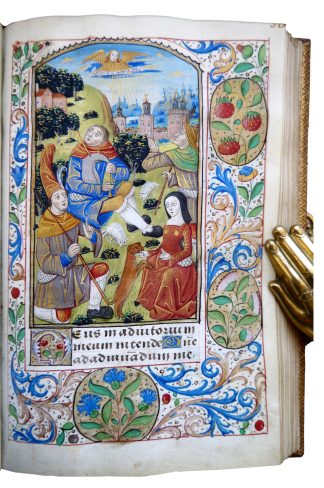BOOK OF HOURS
Use of Rouen, in Latin, illuminated manuscript on vellum
Northern France, (Rouen), c. 1500£125,000.00
180 by 116mm., 85 leaves (plus one eighteenth- or early nineteenth-century vellum endleaf with new frontispiece and 4 paper endleaves at each end), complete, collation: i6, ii-vii8, viii6, ix10, x6, xi9 (last a cancelled blank), with eighteenth- or early nineteenth-century pen foliation 1-87, including new frontispiece, followed here, single column, 23 lines in a professional letter batârde, capitals touched in yellow, dark red rubrics, one-line initials in liquid gold on burgundy or blue grounds, with line-fillers in same, larger initials in scrolling white acanthus leaf sprays enclosing foliage sprays and on gold grounds, each text leaf with decorative border panels of gold and coloured acanthus leaves and other foliage and fruit, Calendar in gold, blue and red ink opening with similar white acanthus initials, each leaf accompanied by vignettes with the occupations and zodiac symbols set within full decorated borders, one leaf with a similar vignette of the Annunciation to the Virgin (opening Matins in the Hours of the Virgin) set within a full decorated border enclosing a brown roaring quadruped in the bas-de-pas, thirteen three-quarter page arch-topped miniatures (see below), with full borders of acanthus leaves and other foliage set on shapes of dull gold or blank vellum, one full-page miniature of the tree of Jesse set on striking black background (see below), slightly trimmed at edges damaging only modern foliation, occasional small chips to paint and gold, small smudges to base of Tree of Jesse miniature, and very small spots, else in excellent condition, in late seventeenth or early eighteenth century red morocco over pasteboards, gilt-tooled with curled ropework frame around edge of each board, profusely gilt-tooled with floral compartments on spine, marbled endleaves, some slight bumps to edges.
The volume comprises: a Calendar (fol. 2r); the Passion Readings (fol. 7r); the Obsecro te (fol. 12r) and the O intemerata (fol. 14r); the Hours of the Virgin (fol. 16v), opening “Hore intemerate virginis marie secundum usum rothom[agum]”, interspersed with the Hours of the Cross and Holy Spirit, with Matins (fol. 16v), Lauds (fol. 23r), Prime (fol. 32r), Terce (fol. 36r), Sext (fol. 39r), None (fol. 41v), Vespers (fol. 44r) and Compline (fol. 46v); the Penitential Psalms (fol. 50r), followed by a Litany; the Ofiice of the Dead (fol. 62r); followed by the Doulce dame (fol. 80v), the Doulx dieu (fol. 84r) in French, and Suffrages to the Saints.
The rich palette of reds, gold and even black (used as a background for the Tree of Jesse miniature, as well as dark shading underneath the branches of trees) as well as the distinctive border decoration is redolent of Rouen work of the last decades of the fifteenth century, most notably miniatures often attributed to Robert Boyvin (c. 1470-after 1536), who worked for Cardinal Georges d’Amboise (archbishop of Rouen from 1493 until his death on 25 May 1510) as well as many other clients (see I. Delaunay, ‘Le manuscrit enluminé à Rouen au temps du cardinal Georges d’Amboise: l’œuvre de Robert Boyvin et de Jean Serpin’ in Annales de Normandie 45e année, 3, 1995, pp. 211-244). Of particular note here are the striking image of the Tree of Jesse and the uncommon image of the meeting of three living and three dead.
The large miniatures are: 1. fol. 8r, St. John on Patmos seated before his attribute the eagle, writing on a scroll; 2. fol. 16r, The tree of Jesse, with Jesse as a bearded sleeping fifure reclining at the foot of the leaf, with a twisted tree emerging from his chest and branching off with half-length portraits of the various kings in gold and coloured robes emerging from the buds at the end of some of its branches, the highest stalk containing the Virgin and Child, all on black ground and within architectural columns and architrave containing Adam, Eve and the Serpent in the centre; 3. fol. 23r, the Vistation of the Virgin to St. Anne before a medieval walled city; 4. fol. 30r, the Crucifixion, with a crowd at the foot of the Cross; 5. fol. 31r, Pentecost, with the Virgin standing within a gothic interior as the Holy Spirit in the form of a dove descends; 6. fol. 32r, the Nativity, with two peasants gazing up at the star in the background, with a bird and a drollery-creature in the border; 7. fol. 36r, Annunciation to the Shepherds, one with a bagpipe and another with a staff and a long tall hat; 8. fol. 39r, the Adoration of the Magi, all in rich robes; 9. fol. 41v, the Presentation in the Temple, set within an opulent gothic ecclesiastical interior; 10. fol. 44r, Flight into Egypt, with a soldier greeting a peasant before a field of ripe corn in the background (an apparent reference to the miracle of the instantaneous harvest, in which the soldier returns to the field only a few months after harvest to discover the peasants cutting the second and miraculous crop); 11. fol. 46v, the Coronation of the Virgin, as she kneels before God the Father; 12. fol. 50r, King David kneeling, his harp before him, as God appears in the sky through a window; 13. fol. 62r, the Meeting of the Three Living and the Three Dead, with the living on horseback as three grinning skeletons greet them at the crossroads before a medieval walled town; 14. fol. 80v, the Virgin and Child enthroned with the original owner kneeling before them.
Provenance:1. Written and illuminated for the Rouen noblewoman whose appears kneeling in a black headdress and red robe with a gold pendant around her neck in adoration of the Virgin and Child in the miniature accompanying the Doulce Dame (fol. 81v). The Hours of the Virgin are of the Use of Rouen, and the Calendar has St. Romanus (bishop of the city, d. 640, feast: 23 October) in gold.2. R. Zierer: his modern bookplate pasted to front pastedown.In stock



